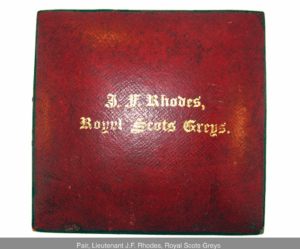‘Mishap’ at Klippan
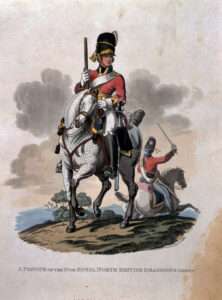
Private of the Royal Scots Greys
The Second Boer War, now most often referenced as the South African War, was the second of two wars between Britain and the republics of the Transvaal and the Orange Free State (to use the nomenclature of the time). The Boers were descendants of the Dutch, German and French settlers who first arrived in the Cape of Good Hope in 1652. ‘Boer’ is derived from the Afrikaans word for farmer. The main causes of the war were: expansion of the British Empire, problems with the Transvaal government, the British annexation of the Transvaal and the Boer opposition to British rule there. It began in 1899 and ended in 1902.
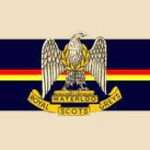
Flag of the Royal Scots Greys
The Royal Scots Greys were an old cavalry regiment of the British Army first formed in 1707. Their involvement in the South African War began when they sailed for the Cape in December, 1899, initially taking up patrol and supply line protection. Later they took part in the relief of Kimberley and the advance on Bloemfontein and Pretoria. Commanding a troop of about 32 men was a newly minted Lieutenant, promoted in September, 1900, named John Rhodes. John Fairfax Rhodes was the eldest and only son of Frederick Fairfax Rhodes and Mary, his wife, owner of Brockhampton Park; he was born in December, 1877, educated at Eton and had entered the regiment in June, 1899.
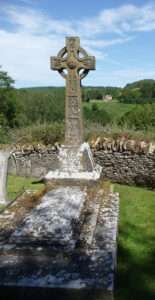
John Rhodes grave at Charlton Abbots
On February 18 of 1902, scouts discovered a large force of Boers camped at Klippan, twenty miles from a town called Springs in the Transvaal, estimated to number about 500. The Greys were part of a larger force commanded by General Gilbert Hamilton. The General should have ordered an immediate attack, but lost the element of surprise by delaying, enabling the Boers to harness their wagons and take up a strong defensive position. Hamilton sent only a part of his force into the attack, with the Greys detached to execute a flanking manouvre, however, he failed to order support and the attackers were obliged to retreat, leaving the Greys cut off and unable to extricate themselves. The squadron Commander and Adjutant were both mortally wounded, expiring two days later and, among several others, Lieutenant Rhodes was killed during the engagement. It was the last battle the Greys fought, as the war ended soon after. It was common at the time to refer to more minor engagements such as at Klippan as ‘mishaps’ though it was, of course, a tragedy for the family of John Fairfax Rhodes.
The remains of Lieutenant Rhodes, accompanied by an escort of a sergeant and eight men, were conveyed to Britain and he was buried at St. Martin’s church, Charlton Abbotts, not two miles from Brockhampton Park. With him went Frederick Rhodes hopes of his son inheriting the house. Recently, John Rhodes service medals and their red leather case went on sale for £1,600, but I have been unable to find out who bought them. They would have made a fitting addition displayed in the entrance hall of the house.
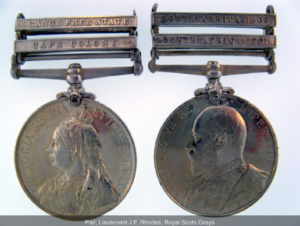
Left: John Rhodes service medals
Right: Display case
